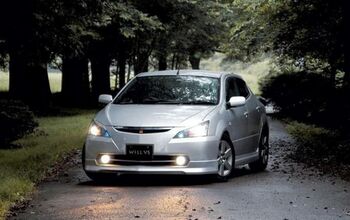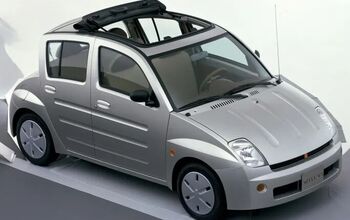Abandoned History: The Early 2000s WiLL Project, for The Youths (Part I)

Today’s Abandoned History story is one of targeted marketing. In the early 2000s, an amalgam of Japanese corporations combined efforts to reach out to younger consumers via unified branding. Cars, food, appliances – all across Japan new, youth-focused products all wore the same sub-brand: WiLL.
Collectively WiLL asked, “How do you do, fellow kids?”
The WiLL marketing project started in August 1999 and ran through July 2004. Seven Japanese companies banded together in a concerted effort to attract the yen of young people. While the WiLL project became known mostly for its resultant cars, those were just the most costly products from the project.
WiLL offered food, paper and office goods, tourist attractions, consumer electronics, alcohol, and home goods in addition to cars. Beer producer Asahi marketed three new types of alcohol under the WiLL brand. They were joined by candy maker Ezaki Glico, who made their own WiLL candies and chocolates. WiLL products wore the effort’s unified logo, a small (usually) orange square.
On the home goods and electronics front, Panasonic and Kao Corporation offered exciting new WiLL products. Kao produced three WiLL-branded air fresheners, while Panasonic offered 14 different consumer goods under WiLL. Said goods appealed to younger consumers of different ages and incomes, as they ranged from fax machines to microwaves, fridges, washing machines, and even a collapsible bike. Consumers of the WiLL Panasonic fax machine might have filled it with new WiLL stationary and used the assorted pens offered by Kokuyo. Kokuyo is an office furniture and paper producer.
There were also WiLL-branded services offered by the Kinki Nippon Tourist company. Kinki created tours exploring different parts of Japan that were designed specifically for younger consumers. Tours took place in Kyushu, Okinawa, Hokkaido, and there was a general “Sports Tour” as well.
Finally, there were the most expensive WiLL products: A series of four different Toyota compacts intended to draw upon the styling of extant vehicles, and appeal almost exclusively to a younger audience. All of the WiLL cars looked very different from one another, and none were produced for very long.
The WiLL project was created based on an engineering theory called Kansei. The principle of Kansei is to develop or improve consumer products and services by understanding and incorporating a consumer’s psychological wants and needs into a product’s design. With this methodology, Kansei engineering can create products that drive an intended feeling within the consumer and generate sales. With WiLL, the desired feeling was “This is made just for me as a young consumer.”
So did it work? Yes and no, mostly no. The WiLL products had varying success generating buzz in the Japanese market, but the cars, in particular, were underwhelming where sales were concerned. Having said that, some WiLL products are still around today. There was another, simultaneous Kansei project in Japan that most certainly had a direct effect on the North American automotive landscape, it just took a while. Not much car talk this time (gasp!), but we’ll get to that in Part II.
[Images: Panasonic, Toyota, Kokuyo, Kao, Asahi]

Interested in lots of cars and their various historical contexts. Started writing articles for TTAC in late 2016, when my first posts were QOTDs. From there I started a few new series like Rare Rides, Buy/Drive/Burn, Abandoned History, and most recently Rare Rides Icons. Operating from a home base in Cincinnati, Ohio, a relative auto journalist dead zone. Many of my articles are prompted by something I'll see on social media that sparks my interest and causes me to research. Finding articles and information from the early days of the internet and beyond that covers the little details lost to time: trim packages, color and wheel choices, interior fabrics. Beyond those, I'm fascinated by automotive industry experiments, both failures and successes. Lately I've taken an interest in AI, and generating "what if" type images for car models long dead. Reincarnating a modern Toyota Paseo, Lincoln Mark IX, or Isuzu Trooper through a text prompt is fun. Fun to post them on Twitter too, and watch people overreact. To that end, the social media I use most is Twitter, @CoreyLewis86. I also contribute pieces for Forbes Wheels and Forbes Home.
More by Corey Lewis
Latest Car Reviews
Read moreLatest Product Reviews
Read moreRecent Comments
- Jalop1991 Nissan is Readying a Slew of New Products to Boost Sales and ProfitabilitySo they're moving to lawn and garden equipment?
- Yuda I'd love to see what Hennessy does with this one GAWD
- Lorenzo I just noticed the 1954 Ford Customline V8 has the same exterior dimensions, but better legroom, shoulder room, hip room, a V8 engine, and a trunk lid. It sold, with Fordomatic, for $21,500, inflation adjusted.
- Lorenzo They won't be sold just in Beverly Hills - there's a Nieman-Marcus in nearly every big city. When they're finally junked, the transfer case will be first to be salvaged, since it'll be unused.
- Ltcmgm78 Just what we need to do: add more EVs that require a charging station! We own a Volt. We charge at home. We bought the Volt off-lease. We're retired and can do all our daily errands without burning any gasoline. For us this works, but we no longer have a work commute.








































Comments
Join the conversation
WiLL was such a roaring success they decided to proceed with Scion anyways. The Japanese consumer is very different from the American perhaps they though. The WiLL VS was an awesome car. Too bad they didn’t bring those to the US.
If only they could have gotten WiLL Smith as their spokesman, maybe it could have worked.